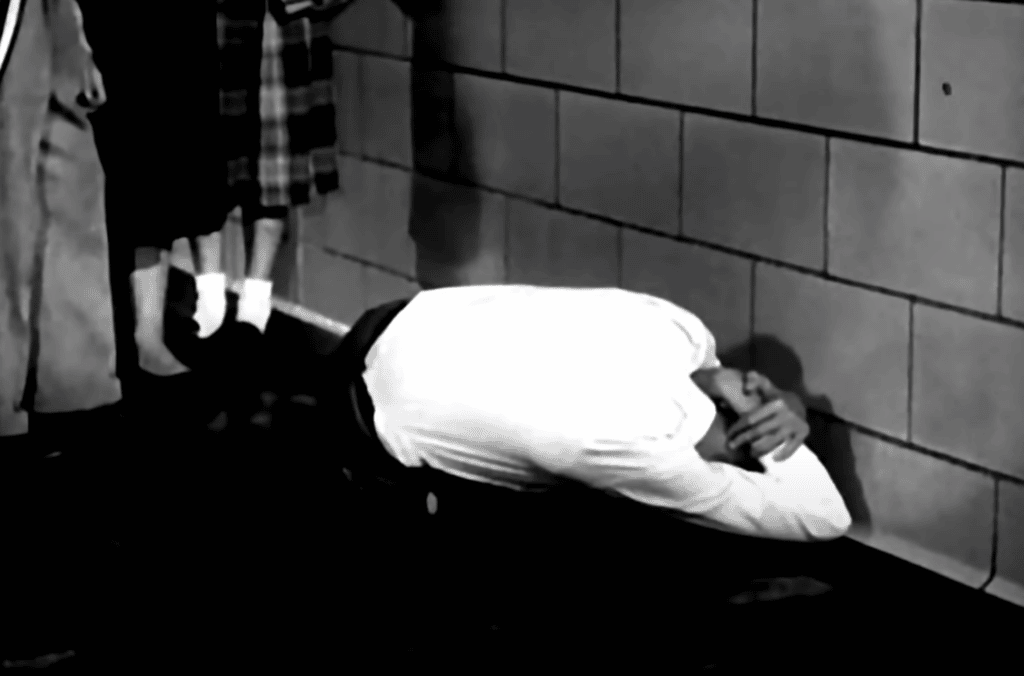This is an official New York City video about how to survive a nuclear attack. Please do not freak out.
By John Mecklin | July 13, 2022
 A screen shot from the Prelinger Archive's print of "Duck and Cover" (ca. 1951). "Duck and Cover" is a Civil Defense film, demonstrating the "Duck and Cover" technique of minimizing harm from a nuclear blast. Source: Official publications of the US government.
A screen shot from the Prelinger Archive's print of "Duck and Cover" (ca. 1951). "Duck and Cover" is a Civil Defense film, demonstrating the "Duck and Cover" technique of minimizing harm from a nuclear blast. Source: Official publications of the US government.
It didn’t quite have “duck and cover” urgency, and no one was told to hide under a desk. Still, the New York City Emergency Management department’s new public service announcement on nuclear preparedness seemed to raise (and in some cases singe) eyebrows across the media ecosphere this week. The video PSA is actually pretty matter of fact, telling New Yorkers the three things they should do in case of nuclear attack: get inside, stay inside, and stay tuned to media and governmental updates on conditions.
To be sure, the announcement does not make any mention whatsoever of the grisly reality: Anyone anywhere near ground zero will be vaporized, turned to ash, asphyxiated, dismembered, or worse by a nuclear blast. Still, in a lengthy Twitter thread, prominent nuclear historian and civil defense expert Alex Wellerstein gave his views on why this kind of messaging can be valuable by helping to avoid “preventable casualties” in outlying areas. The thread also offers his thoughts on how the kind of “sanitized” messaging offered in the New York video can be improved with controlled doses of grim reality and a lot of message testing among varied demographic groups.
Some thoughts on the NYC Civil Defense spot that people have been mostly piling on today… https://t.co/EnGjSuAjVb
— Alex Wellerstein (@wellerstein) July 12, 2022
Equally prominent nuclear expert Jeffrey Lewis posted his own lengthy Twitter take, which was decidedly more critical of New York’s nuclear PSA, contending its advice is “not much more than ‘thoughts and prayers.’ A lot of civil defense advice is like that—it’s designed to make people feel better without really leveling with them.” As with Wellerstein, most anything Lewis writes is worth your time. Lewis will also almost always make you laugh; if for no other reason, you should read his thread to obtain his quality advice for the best way to deal with the “imminent drop of ‘the big one’ on the Big Apple.” (And no, I’m not going to be a spoiler; you have to read it for yourself.)
New York City has a new PSA on what to do if the city is struck by a nuclear weapon. The advice isn’t wrong, it’s just … unhelpful.https://t.co/1VYITSPVeu
— Dr. Jeffrey Lewis (@ArmsControlWonk) July 11, 2022
A plethora of news and pseudo-news sites covered the public service announcement in ways that, despite their varying worldviews, seemed generally to involve sneering—from the right-wing Daily Caller (“bizarre”) to the World Socialist Web Site (“Everything about the video, from its breezy narration to its trivial advice, is completely absurd”).
The Washington Post provided the most straightforward news approach I saw in my admittedly less-than-comprehensive review of coverage, going straight to its politics and accountability forte to question New York Mayor Eric Adams’ judgement in green-lighting the video, which he called a “very proactive step” sparked by Russia’s invasion of Ukraine. “I’m a big believer in ‘Better safe than sorry,’” the Post quoted the mayor as saying.
The Post pointed out that the video wasn’t posted until months after Russia invaded Ukraine and noted that it “raised alarm and prompted some head-scratching” with quotes from several citizens who expressed real alarm or puzzlement. Then, true to its news roots, the newspaper allowed the mayor the last word: “I don’t think it was alarmist … These are just smart things to do.”
Together, we make the world safer.
The Bulletin elevates expert voices above the noise. But as an independent nonprofit organization, our operations depend on the support of readers like you. Help us continue to deliver quality journalism that holds leaders accountable. Your support of our work at any level is important. In return, we promise our coverage will be understandable, influential, vigilant, solution-oriented, and fair-minded. Together we can make a difference.
Keywords: Alex Wellerstein, Civil defense, Jeffery Lewis, New York City, Ukraine, duck and cover, public service announcment
Topics: Nuclear Risk, Nuclear Weapons















This is the context that should have been set in such an ad, from https://thebulletin.org/2015/02/what-would-happen-if-an-800-kiloton-nuclear-warhead-detonated-above-midtown-manhattan/ Within tens of minutes, everything within approximately five to seven miles of Midtown Manhattan would be engulfed by a gigantic firestorm. The fire zone would cover a total area of 90 to 152 square miles (230 to 389 square kilometers). The firestorm would rage for three to six hours. Air temperatures in the fire zone would likely average 400 to 500 degrees Fahrenheit (200 to 260 Celsius). After the fire burned out, the street pavement would be so hot that even tracked vehicles could not pass… Read more »
I know that, in the 1970s and 1980s, something like 80 thermonuclear warheads were targeted on Moscow alone. I suspect a similar number had NYC s as a target. I have no idea how many are presently so deployed by the US and Russia; but I suspect the harsh truth is that such a war is not survivable in any meaningful sense.